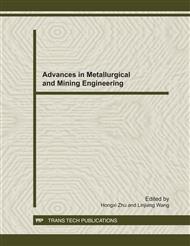p.518
p.523
p.526
p.529
p.535
p.542
p.546
p.552
p.556
Industry Test on Phosphorus Removal and Direct Reduction of High-Phosphorus Oolitic Hematite Ore
Abstract:
Industry test on phosphorus removal and direct reduction of the “Ningxiang type” high-phosphorus oolitic hematite ore has been carried out in a tunnel kiln on the basis of laboratory experiment. The iron grade and phosphorus content of the initial sample are 42.46% and 0.867%, respectively. The results showed that high-phosphorus oolitic hematite could be exploited on industrial scale, with the new process direct reduction roasting – grinding – magnetic separation, and that the final concentrate with an iron grade 92.56%, iron recovery 82.77% and phosphorus content 0.089% was obtained under the optimal conditions. Besides, X-ray diffraction (XRD) and scanning electron microscope with X-ray energy dispersive spectrum (SEM-EDS) were used to analysis the mechanism of phosphorus removal and direct reduction. It was shown that oolitic structure was destroyed, and metallic iron particle coarsening was obvious, besides fluorapatite particles were dispersed in the gangue by diffusion during the reduction roasting process. The liberation of metallic iron and gangue can be achieved by grinding, so high iron grade and low phosphorus content concentrate can be obtained after magnetic separation.
Info:
Periodical:
Pages:
535-541
Citation:
Online since:
November 2011
Authors:
Price:
Сopyright:
© 2012 Trans Tech Publications Ltd. All Rights Reserved
Share:
Citation:


